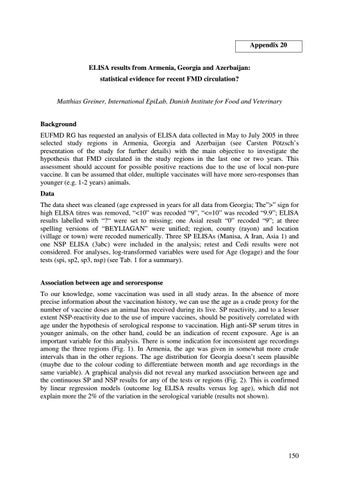Appendix 20 ELISA results from Armenia, Georgia and Azerbaijan: statistical evidence for recent FMD circulation? Matthias Greiner, International EpiLab, Danish Institute for Food and Veterinary Background EUFMD RG has requested an analysis of ELISA data collected in May to July 2005 in three selected study regions in Armenia, Georgia and Azerbaijan (see Carsten Pötzsch’s presentation of the study for further details) with the main objective to investigate the hypothesis that FMD circulated in the study regions in the last one or two years. This assessment should account for possible positive reactions due to the use of local non-pure vaccine. It can be assumed that older, multiple vaccinates will have more sero-responses than younger (e.g. 1-2 years) animals. Data The data sheet was cleaned (age expressed in years for all data from Georgia; The”>” sign for high ELISA titres was removed, “<10” was recoded “9”, “<=10” was recoded “9.9”; ELISA results labelled with “?“ were set to missing; one Asial result “0” recoded “9”; at three spelling versions of “BEYLIAGAN” were unified; region, county (rayon) and location (village or town) were recoded numerically. Three SP ELISAs (Manisa, A Iran, Asia 1) and one NSP ELISA (3abc) were included in the analysis; retest and Cedi results were not considered. For analyses, log-transformed variables were used for Age (logage) and the four tests (spi, sp2, sp3, nsp) (see Tab. 1 for a summary). Association between age and seroresponse To our knowledge, some vaccination was used in all study areas. In the absence of more precise information about the vaccination history, we can use the age as a crude proxy for the number of vaccine doses an animal has received during its live. SP reactivity, and to a lesser extent NSP-reactivity due to the use of impure vaccines, should be positively correlated with age under the hypothesis of serological response to vaccination. High anti-SP serum titres in younger animals, on the other hand, could be an indication of recent exposure. Age is an important variable for this analysis. There is some indication for inconsistent age recordings among the three regions (Fig. 1). In Armenia, the age was given in somewhat more crude intervals than in the other regions. The age distribution for Georgia doesn’t seem plausible (maybe due to the colour coding to differentiate between month and age recordings in the same variable). A graphical analysis did not reveal any marked association between age and the continuous SP and NSP results for any of the tests or regions (Fig. 2). This is confirmed by linear regression models (outcome log ELISA results versus log age), which did not explain more the 2% of the variation in the serological variable (results not shown).
150
